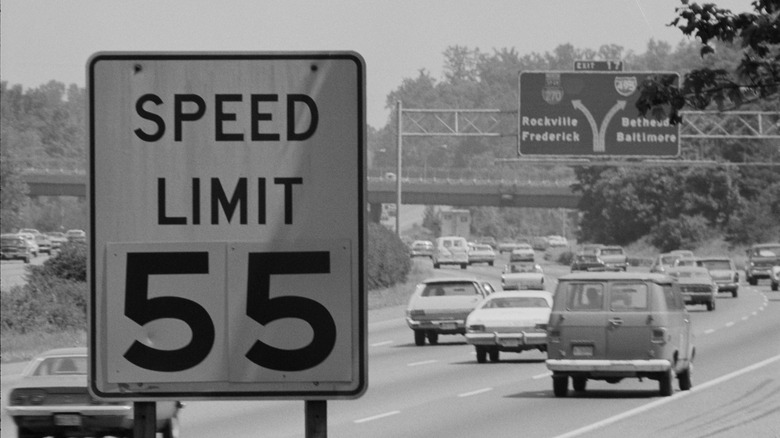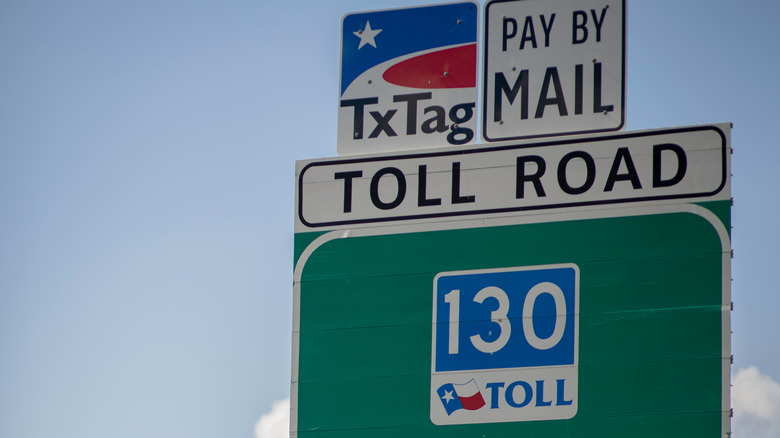How A War In The Middle East Caused Speed Limits To Go Down In The US
Another truly terrible thing about warfare is the scale of it all. In addition to the tragic number of lives lost, the physical destruction of cities, and the severing of international relations, warfare can also shatter global economies with far-reaching consequences. The war in Ukraine, for instance, has had a profound effect on global oil prices because Russia is one of the world's biggest producers. A war in the Middle East in the 1970s also caused prices to change, along with speed limits, in the U.S.
The Yom Kippur War began on October 6, 1973, when Syrian and Egyptian forces attacked Israel. Although the war was short-lived, lasting only 20 days, its impact was felt very keenly in the United States. That's because a little more than a week after the war began, the U.S. began to provide Israel's forces with supplies. Because the Soviet Union was doing the same for its own allies, the conflict became something of a proxy war for the two. It was partially due to American aid that the Israel Defense Forces were able to recover from the precarious position they had been in at the war's beginning and fight on until a United Nations Security Council resolution made continued conflict untenable.
American support of Israel increased tensions between the United States and Middle Eastern countries. As a result, Middle Eastern members of the Organization of Petroleum Exporting Countries placed an embargo on American deliveries, making prices for consumers increase four-fold. It was this oil embargo that ultimately reduced U.S. speed limits as well, as the nation fought to save precious fuel wherever it could.
The United States' response to the oil embargo
The U.S. has historically had a taste for more powerful engines, and said engines often came more hungry for fuel. However, adjustments had to be made. Under the pressure of the oil embargo, some rather questionable Ford cars were developed. The Cadillac Seville was also a prominent example of a vehicle that was developed as a result of the fuel crisis. Yet action had to be taken in broader scope as well to really cut back on fuel usage.
In 1973, the Reagan administration created the Project Independence initiative to try and handle more of the country's energy needs domestically, rather than having to rely on other countries. This initiative involved sweeping measures, such as adjusting national plane and ship schedules, maximizing coal use in tandem with limiting aircraft fuel, and implementing the Emergency Highway Energy Conservation Act. This act, which was signed into law in January 1974, was an attempt to curb energy use by cutting the speed limit on highways around the country to 55 mph.
The idea was to keep vehicles moving at fuel-efficient speeds, and the best way to do so, it was decided, was to make those speeds uniform rather than having them differ significantly from state to state. It wasn't just the United States that was impacted, either. Britain also adopted similar measures in December 1974. In addition to reducing the limit to 60 mph on dual carriageways and 50 mph on other roads, the country also doubled the penalty for speeding.
How long the new speed limit lasted and the effects it had
The Emergency Highway Energy Conservation Act did reduce fuel consumption, which makes sense considering slowing vehicles does tend to increase fuel efficiency. The Department of Energy, for instance, notes that fuel efficiency starts to decline after about 50 mph, such that each 5 mph over the speed limit translates to paying about $0.27 per gallon. Between 1972 and 1974, the average speed on U.S. highways decreased about 9%. This was thought to translate to between a 1% and 3% reduction in fuel, according to a 1983 paper published in the scientific journal Resources and Energy.
There's more to consider than just the economy, too. The speed limit reduction also seemed to make the roads safer. The American Safety Council reports that between 1974 and 1983, deaths per one million miles traveled on America's roads fell from 4.28 to 2.73. Despite these benefits, the act was ultimately appealed in November 1995, making speed limits on U.S. roads highly variable by road type and location again. These days, Texas has the highest speed limit in the country, with one road having an 85 mph limit. Meanwhile, D.C.'s 55 mph limit for rural freeways is the lowest.


